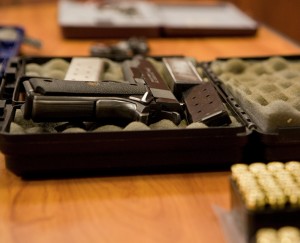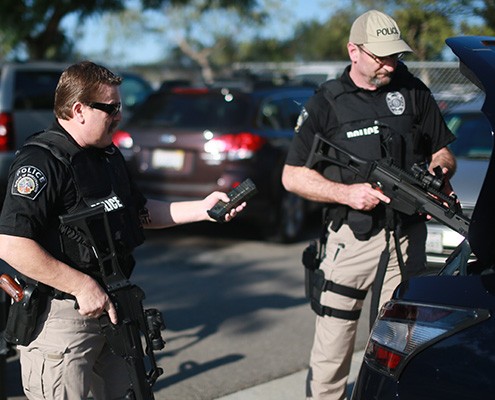Major cases included:
People v. Treviyon Ruew
In July 2010, defendant Treviyon Ruew went on a crime spree throughout San Diego. It began with a carjacking in an apartment complex as the victim returned home and was parking his car. The defendant and a fellow gang member approached the victim, demanded his car, and shot the victim multiple times. Miraculously, the victim survived. Later that same night, three students visiting from Ireland were standing in front of a hostel when they, too, were approached by these armed gang members, who robbed them of their property. Two days later, gang member Ruew came upon victims sleeping in their car, who had been unable to find a hotel room due to the Comic-Con convention. The defendant stole their Comic-Con money (over $3,000) and passports and fired his handgun in order to hurry the victims along. A half an hour later, Ruew found another victim sleeping in his car and attempted a carjacking. The defendant fired multiple rounds into the car, hitting one victim in the shoe. The crime spree came to an end four days later when police officers, who were conducting surveillance on the defendant’s grandfather’s house, saw the defendant emerge. He managed to make it into a waiting car and a high speed chase ensued. The defendant tried to escape, but was captured. Ruew was convicted and sentenced to more than 125 years in prison.
People v. Terrence Jarvis
Just after Christmas in 2011, local gang members, including defendant Terrence Jarvis, gathered to attack a person they believed had not been sufficiently loyal to the gang. They approached the victim as if to engage him in friendly conversation, then sucker punched and attacked him before fleeing. Later that same evening, the defendant approached a woman who had just parked her car and began to walk into her apartment complex. Armed with a double-barrel shotgun, Jarvis demanded everything she had, slapped her in the face, went through her pockets, and threatened more harm if she reported the incident. Less than an hour later, an employee of a local pizza restaurant was taking out the garbage when the she felt someone reaching into her pockets from behind. She turned to see Jarvis brandishing a shotgun. He demanded everything she had, but she repeatedly told him she didn’t have anything of value. The defendant fled in search of another victim, whom he found less than two miles away. The visiting UC Berkeley freshman had just finished spending the evening touring San Diego with his girlfriend and had driven himself to the house where he was staying. The exact events are unknown due to the extensive head injuries inflicted on the victim, but 20 minutes after the attempted robbery of the pizza employee, the UC Berkeley freshman was found on the sidewalk by a neighbor – he had been beaten nearly to death and robbed. Rounding out the night of terror, the defendant returned to the home of the person they had initially beaten and fired multiple shotgun and rifle rounds through the windows of the house in which the victim’s family and his grandmother were sleeping. The accomplice pleaded guilty before trial and was sentenced to 22 years in prison. After Jarvis’ trial, he was sentenced to more than 160 years in prison.
People v. Antwaren Roberts
In December 2013, a young pregnant woman was shot multiple times in retaliation for implicating local gang members – including the defendant – in the shooting death of her friend. As the victim was with hanging out with friends playing dice on a downtown San Diego street, defendant Roberts shot the victim multiple times in the chest and torso. She and her unborn baby survived and defendant Roberts was convicted of attempted murder. He is facing more than 40 years in prison.
People v. Rene Sanchez
In 2007, 16-year-old defendant Rene Sanchez and his fellow gangsters crashed a family Halloween party being held in a backyard. The homeowners asked defendant Sanchez and the other gang members to please leave the party as it was family event. A confrontation between the hosts and gang members ensued with the melee culminating in a shooting. Sanchez shot one victim five times and shot another victim in the back. As parents hurried to get their children safely inside the house and as others jumped the fence to escape, fellow gang member, Jaime Reyes, stabbed the hostess in the chest four times on his the way out. Sanchez and Reyes both fled to Mexico. The U.S. Marshals located Sanchez and he was extradited San Diego to face trial. A jury found him guilty of first-degree murder and other charges. He was sentenced to 50 years-to-life in prison.
People. V. Jorge Rojas and Juan Estrada, People v. Edgar Lopez-Frausto
Between 2004 and 2007, members of the Los Palillos criminal organization abducted, tortured, extorted and ultimately killed nine people in various locations throughout San Diego County. The bodies of seven of those victims were left decomposing in vehicles on the side of the road, accompanied by messages directed at both law enforcement and the gang’s rivals. The gang’s last two victims were beaten and strangled to death after the family of one of the victims made two ransom payments for their release. Their bodies were dissolved in 55-gallon drums filled with acid. The liquefied remains were poured into a makeshift grave at a ranch in southern San Diego along the Mexican border.
In 2009, 18 members of Los Palillos were indicted on 22 felony counts, including nine special circumstance murders, numerous kidnappings for ransom, robberies and the attempted murder of a Chula Vista police officer. To date, eight defendants have been convicted and each is serving life in prison without the possibility of parole. This includes the gang’s two leaders, Jorge Rojas Lopez and Juan Estrada Gonzalez, whose trial concluded in March of 2014 following seven full months of evidence. In December 2014, Edgar Lopez-Frausto was convicted of first-degree murder with kidnapping, torture and gang special circumstances plus kidnapping for ransom, following a three-month trial. He faces multiple life without parole sentences.
 Last year, the Gangs Division continued its proactive role with local, state, and federal law enforcement. Prosecutors and investigators participated on numerous task forces targeting gang members and the crimes they commit. The Gangs Division is currently prosecuting defendants from takedowns of three major gangs in San Diego. With these arrests, shootings in the affected neighborhoods have gone down more than 50 percent.
Last year, the Gangs Division continued its proactive role with local, state, and federal law enforcement. Prosecutors and investigators participated on numerous task forces targeting gang members and the crimes they commit. The Gangs Division is currently prosecuting defendants from takedowns of three major gangs in San Diego. With these arrests, shootings in the affected neighborhoods have gone down more than 50 percent.


